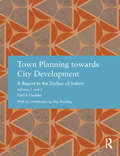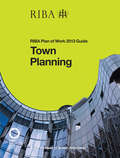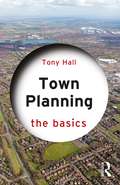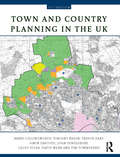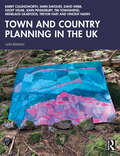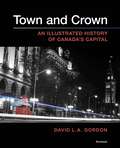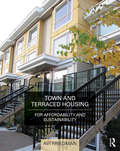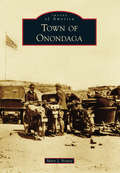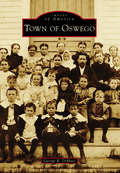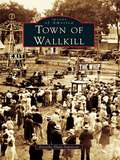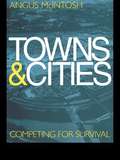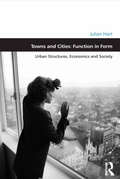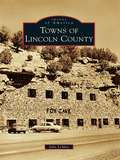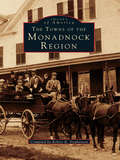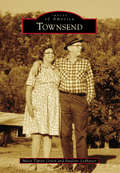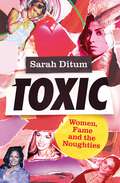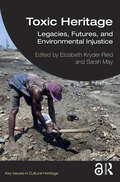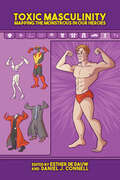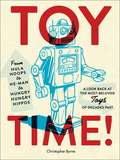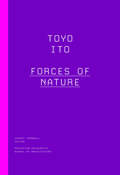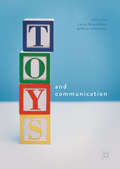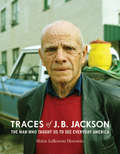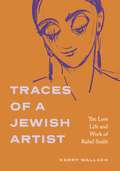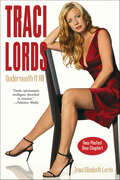- Table View
- List View
Town Planning towards City Development: A Report to the Durbar of Indore (Studies in International Planning History)
by Patrick GeddesPatrick Geddes is one of the most important figures in planning history, variously presented as an inspiration to regional planning, environmental planning and sustainability, grass-roots planning, citizen democracy, historic preservation, neighbourhood upgrading, university–community partnership, lifelong learning, and co-operative housing. Though well-known and often praised by planning historians, his scholarship extended across a much broader range of disciplines, with extensive publication on biology and on civics, and significant contributions to sociology, economics, geography, education, and the arts and humanities. With the exception of his plan of Dunfermline, published in 1904, his plans are very hard to find. Most of his plans were prepared in India between 1915 and 1923, but beyond brief extracts from four of them included by Jaqueline Tyrwhitt in the book Patrick Geddes in India, they are very difficult to obtain. Some are lost altogether and the remainder are available in a handful of libraries, often held in Archives. Of all the plans prepared after Dunfermline, the most extensive is for the city of Indore, originally published in two volumes that combine a comprehensive scheme for the urban development of the city with a detailed plan for the proposed University of Central India.
Town Planning: RIBA Plan of Work 2013 Guide
by Ruth ReedThe RIBA Plan of Work 2013 Guide: Design Management is part of a brand new series providing must-read practical guidance to running efficient and successful projects using the new RIBA Plan of Work 2013. Each guide takes a core project task – in this case those associated with planning - and explains the essential activities and considerations required at each stage of the new Plan of Work. Easy to use and navigate and in a small and handy format these guides will provide the ultimate quick reference support at your desk or on site. The author provides concise and pragmatic advice rooted in real world experience – a ‘how to’ that will resonate with practitioners. In-text features such as ‘hints and tips’, ‘checklists’, ‘forms and templates’ and ‘signposts’ to trusted resources will provide user-friendly support. Boxed examples will highlight best practice and illuminate common problems and solutions borne of hard won experience.
Town Planning: The Basics (The Basics)
by Tony HallThe planning of urban and rural areas requires thinking about where people will live, work, play, study, shop and how they will get about the place, and to devise strategies for long time periods. Town Planning: The Basics provides a general introduction to the components of urban areas, including housing, transportation and infrastructure, and health and environment, showing how appropriate policies can be developed. Explaining planning activity at different scales of operation, this book distinguishes between the "big stuff", the grand strategy for providing homes, jobs and infrastructure; the "medium stuff", the design and location of development; and the "small stuff" affecting mainly small sites and individual households. Planning as an activity is part of a complex web stretching way beyond the planning office, and this book provides an overview of the many components needed to create a successful town. It is invaluable to anyone with an interest in planning, from students learning about the subject for the first time to graduates thinking about embarking on a career in planning, to local councillors on planning committees and community boards.
Town and Country Planning in the UK
by David Webb Barry Cullingworth Geoff Vigar John Pendlebury Simin Davoudi Tim Townshend Trevor Hart Vincent NadinTown and country planning has never been more important to the UK, nor more prominent in national debate. Planning generates great controversy: whether it's spending £80m and four years' inquiry into Heathrow's Terminal 5, or the 200 proposed wind turbines in the Shetland Isles. On a smaller scale telecoms masts, take-aways, house extensions, and even fences are often the cause of local conflict. Town and Country Planning in the UK has been extensively revised by a new author group. This 15th Edition incorporates the major changes to planning introduced by the coalition government elected in 2010, particularly through the National Planning Policy Framework and associated practice guidance and the Localism Act. It provides a critical discussion of the systems of planning, the procedures for managing development and land use change, and the mechanisms for implementing policy and proposals. It reviews current policy for sustainable development and the associated economic, social and environmental themes relevant to planning in both urban and rural contexts. Contemporary arrangements are explained with reference to their historical development, the influence of the European Union, the roles of central and local government, and developing social and economic demands for land use change. Detailed consideration is given to * the nature of planning and its historical evolution * the role of the EU, central, regional and local government * mechanisms for developing policy, and managing these changes * policies for guiding and delivering housing and economic development * sustainable development principles for planning, including pollution control * the importance of design in planning * conserving the heritage * community engagement in planning The many recent changes to the system are explained in detail - the new national planning policy framework; the impact of the loss of the regional tier in planning and of the insertion of neighbourhood level planning; the transition from development control to development management; the continued and growing importance of environmental matters in planning; community engagement; partnership working; changes to planning gain and the introduction of the Community Infrastructure Levy; and new initiatives across a number of other themes. Notes on further reading are provided and at the end of the book there is an extensive bibliography, maintaining its reputation as the 'bible' of British planning.
Town and Country Planning in the UK
by Barry Cullingworth Simin Davoudi David Webb Geoff Vigar John Pendlebury Tim Townshend Menelaos Gkartzios Trevor Hart Vincent NadinTown and Country Planning in the UK provides one of the most authoritative and comprehensive accounts of British planning history, institutions, legislation, policies, processes and practices. This 16th edition has been substantially revised and re-organised to provide an up-to-date overview of the planning systems in the four nations of the UK, supported by analyses, interpretations, illustrations and examples from planning practice.The new edition features: details of the legislative and policy changes since 2015 and discussion of their implications, including the early stages of the Levelling Up and Regeneration Act, 2023 discussion of environmental policies and programmes and the impact of Brexit on environmental regulatory landscape in Britain changes to climate change and resilience policies, notably the government’s ‘Net Zero’ agenda and their implications for planning updates to the substantive issues in plan-making, especially the responses to the shortage of affordable housing and the development of major infrastructure changes to the processes involved in plan-making and development management an expanded and revised chapter on design to include the growing significance of public health in the built environment major revisions to the chapter on rural planning revisions of the text on planning theory especially in relation to management of conflicts over the use and development of land extended discussion of politics, professionalism and participation in planning The 16th edition of Town and Country Planning in the UK is an ideal starting point for those who are studying or working in the planning field, and for other professionals who need to locate their work in the planning context.
Town and Crown: An Illustrated History of Canada’s Capital
by David L. GordonTown and Crown is an illustrated history of the planning and development of Canada’s capital, filling a significant gap in our urban scholarship. It is the story of the transformation of the region from a subarctic wilderness portage to an attractive modern metropolis with a high quality of life. The book examines the period from 1800 to 2011 and is the first major study that covers both sides of the Ottawa River, addressing the settlement history of Aboriginal, French, and English peoples.Ottawa’s transformation was a significant Canadian achievement of the new profession of urban planning in the mid-20th century. Our national capital has the country’s most complete history of community planning and served as a gateway for important international planning ideas and designers. Town and Crown illustrates the influence of landscape architect and Olmsted protégé Frederick Todd, Chicago’s City Beautiful architect Edward Bennett, and British planner Thomas Adams. Prime Minister Mackenzie King maintained a direct interest in planning Canada’s capital for almost fifty years, choosing France’s leading urbaniste, Jacques Gréber, to plan the post-1945 redevelopment of the region.The principal research method for Town and Crown includes over sixteen years of archival studies in North America, Australia, and Europe, and interviews with key politicians, designers, and planners that supplemented the contemporary research. The narrative is supplemented by over 200 images drawn from early sketches, historical maps, plans, and archival photography to illustrate the physical transformation of Canada’s federal capital.
Town and Terraced Housing: For Affordability and Sustainability
by Avi FriedmanRecent societal changes have brought about renewed interest from architects, town planners, housing officials and the public in terraces and townhouses. The small footprint that this style of house occupies allows a sustainable high density approach to habitation, slowing sprawl and creating energy-efficient affordable living. Townhouses have been used for hundreds of years, and their evolution is covered from their inception right up to the present day. With the changing demographics of buyers in mind, Avi Friedman details how the design of these houses can be adapted to keep-up with contemporary needs. Friedman uses a systematic approach to cover the many facets of townhouses from interior design and construction methods, to urban planning issues like adjusting to the site’s natural conditions, street configurations and open spaces. This approach creates a book which will be a valuable resource for those involved in the planning, design and creation of terraced and town houses. Over 150 detailed diagrams and plans, and eighty photos, illustrate the essential elements of this style of housing. In the final chapter, lessons learnt throughout the book are draw together in ten broad ranging case study projects, showing how the various aspects can be put into practice.
Town of Onondaga
by Mary J. NowyjLocated in central New York, the town of Onondaga was incorporated in 1798 and currently consists of eight hamlets within a 65-mile radius. Each hamlet has contributed specifically to the town's rich history and development over the years. Originally part of the Onondaga and Salt Springs Reservations, the region was not part of the Military Tract of Central New York after the Revolutionary War. Individuals arrived for its farmlands, mills, quarries, salt production, and vast topography. A particularly fruitful crop in South Onondaga and Navarino is the apple. The first Onondaga County Courthouse was established here, as was the first county home for the poor. Onondaga Community College (OCC), built on a hilltop, has become an identifiable and highly respectable educational landmark in the town.
Town of Oswego
by George R. DemassThe town of Oswego, located on the shores of Lake Ontario, was established in 1818. It has played a vital role in Central New York's economy with its many fruit orchards, strawberries, and muckland crops of onions, lettuce, and potatoes. Oswego has been on the cutting edge of education and various social reforms. It was home to the first free public school in the area--a one-room schoolhouse on Bunker Hill Road--and today hosts most of the State University of New York at Oswego, founded as the first Normal School in the country. Dr. Mary Edwards Walker, the only woman to receive the Medal of Honor, pioneered women's suffrage and dress reform. Another famous resident, David Hall McConnell, founded the California Perfume Company, now known as Avon Products, Inc. The town of Oswego was and remains a vibrant community of families, many of whom have been there for generations.
Town of Wallkill
by Dorothy Hunt-IngrassiaTown of Wallkill chronicles the history of a town situated midway between two great rivers, the Hudson on the east and the Delaware on the west. It portrays the growth of this community, which was organized in 1772, from homesteads and farms, hamlets and schoolhouses, sawmills and gristmills, to trolleys and parks and beyond.
Towns and Cities: Competing for survival
by Angus McIntosh Dr Angus McintoshThe last fifty years have seen dramatic changes in towns and cities. People have moved out of central urban areas, retailing has moved out of towns and jobs have also declined in city centres, particularly with the growth of business and science parks. With the continuing decline of the manufacturing sector and the re-shaping of employment in the service sector, a new force will increasingly dominate urban development, the meritocratic elite. The meritocratic elite are those able to develop and use information technology to generate productivity and wealth. Where they wish to live will increasingly influence future urban development.Towns and Cities - Competing for survival suggests that as public and private corporations continue to downsize, outsource and re-engineer themselves, an increasing amount of expenditure and employment growth will lie with the leisure sector. Herein lies one of the solutions to the decline of towns and cities.Town planners and economists have continually displayed a lack of understanding of these developments and have not anticipated the forces which cause urban change. As the global econonmy, combined with changes in transport and information technology increasingly dominates our lives, local and national governments need a new agenda for the 21st century. If they fail to rise to this challenge many of our town and city centres will continue to decline and may not survive.
Towns and Cities: Urban Structures, Economics and Society (Design and the Built Environment)
by Julian HartChallenging existing assumptions about how our towns and cities are structured and formed, Julian Hart provides an engaging and thought-provoking alternative theory of urban design. This is not urban design in the sense of the practice of design; rather it is a theory of the form of the town at all scales - why towns and cities happen to be structured the way they are as a result of the social, political, legal and (especially) economic forces that create them. The shape of the city at every scale, from the internal configuration of dwellings all the way up to the superstructure of the whole city, can be seen to arise from the interplay between three antagonistic socio-economic tensions. In going about our daily business and in championing particular political objectives, we collectively fashion our cities in terms of their structure and form. This leads to various new ways of understanding how and why our cities so happen to be configured the way they are. The book makes a step change from any other comparable studies by understanding our towns and cities in terms of function in form. This helps us to appreciate why every town is a recognisable town, wherever it is. Different urban environments in different parts of the world, past and present, can come to be seen according to their similarities instead of their differences. Furthermore, by appreciating how the economic influences of everyday life structure our towns and cities, we can in turn begin to understand better how the shape of towns and cities affects the quality of life of inhabitants and the cohesiveness of communities. In covering all scales from inside the home to macrostructure of the city, the book encapsulates urban design through to town planning and does not seek to distinguish between the various design disciplines.
Towns of Lincoln County
by John LemayLincoln County is often associated with such legendary figures as outlaw Billy the Kid, Smokey the Bear, and renowned painter Peter Hurd. Named after Pres. Abraham Lincoln in 1869, the new county saw itself through many struggles, including the Lincoln County War, during which cattle barons and landowners bitterly fought over government beef contracts and farmland. At that time, Lincoln was the largest county in the United States and is now home to modern mountain towns such as Carrizozo, Capitan, Ruidoso, and the locally famous ghost town White Oaks, which had been a gold rush boomtown. Lincoln County also contains the beautiful Hondo Valley settlements and ranching communities such as Tinnie, Picacho, San Patricio, Hondo, and Glencoe. From the rolling hills of the Hondo Valley, to the bloody streets of Lincoln, all the way to the forested mountains of Capitan, this retrospective explores the area's rich history.
Towns of the Monadnock Region, The
by Robert B. StephensonSince the development of photography in the mid-nineteenth century, the camera has been used as atool of both discovery and preservation. Photographs bring alive our image of the past, and can open a floodgate of memories and nostalgia or inspire curiosity and a sense of history. One of the prominent geological features in the southwest corner of New Hampshire is Grand Monadnock, a bald granite mountain that is a constant presence for miles around. Mount Monadnock gives its name to the beautiful region surrounding its base, a region made up of small towns and villages hundreds of years old, places such as Marlborough and New Ipswich,Peterborough and Rindge, Jaffrey and Hancock, Troy and Fitzwilliam, Harrisville and Dublin. The selection of photographs which make up this charming visual history highlights some of the themes important in the rich history of these communities.Around the landmarks of a village--the meetinghouse and common, the inn and the store--we see work and play, celebration and catastrophe; indeed all the elements of daily life as it was played out over a century of change.
Townsend (Images of America)
by Missy Tipton Green Paulette LedbetterSituated in Tuckaleechee Cove, one of several "limestone windows" on the northern base of the Smoky Mountains, is Townsend, Tennessee, also known as the "Peaceful Side of the Smokies." Native Americans were the first inhabitants of Tuckaleechee Cove. By the time the first Europeans arrived in the late 18th century, the Cherokee villages had been abandoned. In the 1880s, the lumber industry was in full swing thanks to two key innovations: the band saw and the logging railroad. With the coming of industrialization, the isolated farming community of Tuckaleechee Cove was transformed in the bustling mill town of Townsend. In 1894, E.J. Kinzel started a mountain retreat in Tuckaleechee Cove, which in later years turned into a mountain hotel with two healing mineral springs.
Towson
by Melissa SchehleinBefore the birth of our nation, brothers William and Thomas Towson forged a hamlet north of Baltimore on the trade route to York, Pennsylvania, at its junction with a Native American trail known as Joppa Road. In 1854, Towsontown was established as the county seat by popular vote, and the cornerstone of the Baltimore County Courthouse was laid.
Toxic
by Sarah Ditum'Brilliant . . . really made me realise how no one has pulled back and given an overall story to the last 20 years . . . It's clever because it makes me think about now' ADAM CURTIS, FILMMAKERBritney, Paris, Lindsay, Aaliyah, Janet, Amy, Kim, Chyna, Jen. Nine iconic women whose fame in the early internet years of the century came at a price. In Toxic: Women, Fame and The Noughties, journalist Sarah Ditum describes how each of the women changed 'celebrity' forever, despite often falling victim to it, during what we now view as one of the most hostile eras in which to be female.Through Paris' ambivalent relationship with her blogger namesake Perez Hilton; to Britney's paternalistic governors; Jen's attempts to control her career and image; and Janet's betrayal at the Superbowl, these celebrities of The Noughties were presented with the riches of early social media and market opportunity, as long as they abided by the new rules of engagement. Some of these high-profile women were hypersexualised and 'upskirted' by the press; some were shamed by their advertising sponsors; others were contracted by shady management companies and industry figures such as Harvey Weinstein and R Kelly. Together they illuminate the culture of the early twenty-first century. Toxic: Women, Fame and The Noughties is a wild ride through the millennial years.
Toxic Heritage: Legacies, Futures, and Environmental Injustice (Key Issues in Cultural Heritage)
by Sarah May Elizabeth Kryder-ReidToxic Heritage addresses the heritage value of contamination and toxic sites and provides the first in-depth examination of toxic heritage as a global issue. Bringing together case studies, visual essays, and substantive chapters written by leading scholars from around the world, the volume provides a critical framing of the globally expanding field of toxic heritage. Authors from a variety of disciplinary perspectives and methodologies examine toxic heritage as both a material phenomenon and a concept. Organized into five thematic sections, the book explores the meaning and significance of toxic heritage, politics, narratives, affected communities, and activist approaches and interventions. It identifies critical issues and highlights areas of emerging research on the intersections of environmental harm with formal and informal memory practices, while also highlighting the resilience, advocacy, and creativity of communities, scholars, and heritage professionals in responding to the current environmental crises. Toxic Heritage is useful and relevant to scholars and students working across a range of disciplines, including heritage studies, environmental science, archaeology, anthropology, and geography.
Toxic Masculinity: Mapping the Monstrous in Our Heroes
by Esther De Dauw and Daniel J. ConnellContributions by Daniel J. Connell, Esther De Dauw, Craig Haslop, Drew Murphy, Richard Reynolds, Janne Salminen, Karen Sugrue, and James C. Taylor The superhero permeates popular culture from comic books to film and television to internet memes, merchandise, and street art. Toxic Masculinity: Mapping the Monstrous in Our Heroes asks what kind of men these heroes are and if they are worthy of the unbalanced amount of attention. Contributors to the volume investigate how the (super)hero in popular culture conveys messages about heroism and masculinity, considering the social implications of this narrative within a cultural (re)production of dominant, hegemonic values and the possibility of subaltern ideas, norms, and values to be imagined within that (re)production. Divided into three sections, the volume takes an interdisciplinary approach, positioning the impact of hypermasculinity on toxic masculinity and the vilification of “other” identities through such mediums as film, TV, and print comic book literature. The first part, “Understanding Super Men,” analyzes hegemonic masculinity and the spectrum of hypermasculinity through comics, television, and film, while the second part, “The Monstrous Other,” focuses on queer identity and femininity in these same mediums. The final section, “Strategies of Resistance,” offers criticism and solutions to the existing lack of diversity through targeted studies on the performance of gender. Ultimately, the volume identifies the ways in which superhero narratives have promulgated and glorified toxic masculinity and offers alternative strategies to consider how characters can resist the hegemonic model and productively demonstrate new masculinities.
Toy Time!: From Hula Hoops to He-Man to Hungry Hungry Hippos: A Look Back at the Most- Beloved Toys of Decades Past
by Christopher ByrneWhat was your favorite childhood toy? Do you have fond memories of fighting unseen enemies with your G.I. Joe action figures, demolishing fleets of vehicles with your Tonka Toy Trucks, or Karate-chopping imaginary street thugs with your Teenage Mutant Ninja Turtles? What about carefree summer afternoons counting ticks on your Skip-It, scooting around the neighborhood on your Big Wheel, or soaring down your backyard Slip 'n Slide? Still a little bitter that your parents never let you have a Nerf Super Soaker, or a Barbie Dream House? Did you prefer to unleash your inner artist with your Etch a Sketch, or your inner chef with your Easy-Bake Oven? Did you like to challenge your friends to a rousing game of Mousetrap, or did you prefer to get tied up in knots over a round of Twister? In Toy Time! you'll be reunited with all these classic toys and more. No matter when you grew up, or what types of play ignited your imagination, Toy Time! will take you on a journey of rediscovery, allowing you to relive those carefree, innocent, and fun-filled days of childhood. Charming, playful, and full of photos of vintage toys, Toy Time! is an exploration and celebration of the toys that roused our imaginations, shaped our memories, and touched our lives.
Toyo Ito: Forces of Nature
by Jessie TurnbullThe work of Japanese architect Toyo Ito explores the dynamic relationship between buildings and their environments. His principal focus is on developing an architecture free of the grid system, which he believes homogenizes people and their lives. Toyo Ito: Forces of Nature documents the architect's 2009 Kassler lecture at the Princeton University School of Architecture. Told primarily in Ito's own voice, the book features the edited lecture transcript, as well as an interview with the architect by Julian Worrall and a new translation of Ito's 1980 essay "The Projection of the 'Profane' World onto the 'Sacred.'" Projects illustrated in the book include: Berkeley Art Museum and Pacific Film Archive (unbuilt), Taichung Opera House, Tama Art University Library, and Kakamigahara Crematorium. Bringing together different strands of a long and fruitful career, Toyo Ito: Forces of Nature concludes with an afterword by Ito that addresses the exhibition Home for All, a response to Japan's earthquake and tsunami disasters in March 2011.
Toys and Communication
by Jeffrey Goldstein Luísa MagalhãesThere are few scholarly books about toys, and even fewer that consider toys within the context of culture and communication. Toys and Communication is an innovative collection that effectively showcases work by specialists who have sought to examine toys throughout history and in many cultures, including 1930's Europe, Morocco, India, Spanish art of the 16th-19th centuries. Psychologists stress the importance of the role of toys and play in children's language development and intellectual skills, and this book demonstrates the recurrent theme of the transmission of cultural norms through the portrayal, presentation and use of toys. The text establishes the role of toy and play park design in eliciting particular forms of play, as well as stressing the child's use of toys to 'become' more adult. It will be beneficial for courses in education, developmental psychology, communications, media studies, and toy design.
Traces of J. B. Jackson: The Man Who Taught Us to See Everyday America (Midcentury: Architecture, Landscape, Urbanism, and Design)
by Helen L. HorowitzJ. B. Jackson transformed forever how Americans understand their landscape, a concept he defined as land shaped by human presence. In the first major biography of the greatest pioneer in landscape studies, Helen Horowitz shares with us a man who focused on what he regarded as the essential American landscape, the everyday places of the countryside and city, exploring them as texts that reveal important truths about society and culture, present and past. In Jackson’s words, landscape is "history made visible."After a varied life of traveling, writing, sketching, ranch labor, and significant service in army intelligence in World War II, Jackson moved to New Mexico and single-handedly created the magazine Landscape. As it grew under his direction throughout the 1950s and 1960s, Landscape attracted a wide range of contributors. Jackson became a man in demand as a lecturer and, beginning in the late 1960s, he established the field of landscape studies at Berkeley, Harvard, and elsewhere, mentoring many who later became important architects, planners, and scholars. Horowitz brings this singular person to life, revealing how Jackson changed our perception of the landscape and, through friendship as well as his writings, profoundly influenced the lives of many, including her own.
Traces of a Jewish Artist: The Lost Life and Work of Rahel Szalit (Dimyonot)
by Kerry WallachGraphic artist, illustrator, painter, and cartoonist Rahel Szalit (1888–1942) was among the best-known Jewish women artists in Weimar Berlin. But after she was arrested by the French police and then murdered by the Nazis at Auschwitz, she was all but lost to history, and most of her paintings have been destroyed or gone missing. Drawing on a range of primary and secondary sources, this biography recovers Szalit’s life and presents a stunning collection of her art.Szalit was a sought-after artist. Highly regarded by art historians and critics of her day, she made a name for herself with soulful, sometimes humorous illustrations of Jewish and world literature by Sholem Aleichem, Heinrich Heine, Leo Tolstoy, Charles Dickens, and others. She published her work in the mainstream German and Jewish press, and she ran in artists’ and queer circles in Weimar Berlin and in 1930s Paris. Szalit’s fascinating life demonstrates how women artists gained access to Jewish and avant-garde movements by experimenting with different media and genres.This engaging and deeply moving biography explores the life, work, and cultural contexts of an exceptional Jewish woman artist. Complementing studies such as Michael Brenner’s The Renaissance of Jewish Culture in Weimar Germany, this book brings Rahel Szalit into the larger conversation about Jewish artists, Expressionism, and modern art.
Traci Lords: Underneath It All
by Traci Elizabeth LordsThe moving, gripping, and tell–all autobiography of Traci Elizabeth Lords, a former child porn queen, electronica maven, and cult movie and TV star.At 14, Nora Kuzma ran away from home and ended up on the dirty streets of Hollywood. She fell in with a fast crowd, and her dreams of modelling soon landed her a spectacular centrefold in Penthouse Magazine, where at 15 she became internationally known as TRACI LORDS. From there she appeared in numerous adult films and magazines, denying her past and battling a deep addiction to cocaine and men. Three years later she got out. This is her memoir–a tale of loss, redemption, and ultimate survival as Traci Elizabeth Lords takes you into her secretive past, faces her demons, and shares her extraordinary journey of personal growth.
